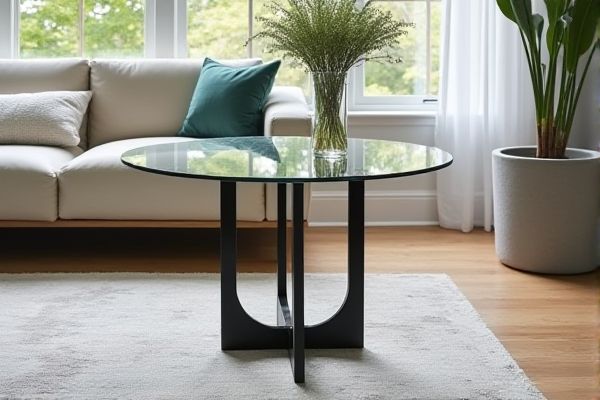
Glass base tables offer a sleek, modern aesthetic with a lightweight feel, while metal base tables provide durability and industrial strength, ideal for heavy use and long-lasting stability. Explore the detailed comparison to determine which table base best suits Your style and functional needs.
Table of Comparison
| Feature | Glass Base Table | Metal Base Table |
|---|---|---|
| Material | Tempered or laminated glass | Steel, aluminum, or iron |
| Durability | Moderate; prone to scratches and chips | High; resistant to dents and corrosion |
| Weight | Heavier due to thick glass | Varies; generally lighter and sturdier |
| Aesthetics | Modern, elegant, transparent look | Industrial, sleek, solid appearance |
| Maintenance | Requires frequent cleaning to avoid smudges | Low maintenance; easy to clean |
| Cost | Usually higher due to glass manufacturing | Generally more affordable |
| Safety | Can shatter if impacted; use tempered glass for safety | Safer; less likely to break or cause injury |
| Environmental Impact | Recyclable but energy-intensive production | Recyclable and often made from recycled metals |
Introduction to Table Base Materials
Glass base tables offer a sleek, modern aesthetic with transparent surfaces that visually enlarge space while requiring careful maintenance to prevent scratches and fingerprints. Metal base tables provide robust durability and stability, often crafted from steel or aluminum, making them ideal for heavy use and industrial design themes. Your choice between glass and metal bases depends on desired style, maintenance preferences, and functional needs.
Overview: Glass Base vs Metal Base Tables
Glass base tables create a sleek, contemporary look with transparency that visually enlarges spaces, while metal base tables offer durability and industrial strength with a variety of finishes like brushed steel or matte black. Both options serve as sturdy foundations, but metal bases often provide greater stability for heavier tabletops, whereas glass bases emphasize elegance and lightness in design. Your choice depends on the desired aesthetic and functional needs, balancing style with structural support.
Aesthetics and Visual Appeal
Glass base tables offer a sleek, modern aesthetic that enhances light flow and creates an open, airy ambiance in your space. Metal base tables provide a bold, industrial look with a variety of finishes that add texture and durability while complementing contemporary or traditional interiors. Choosing between them depends on your preference for transparency and elegance versus strength and statement-making design.
Durability and Longevity
Glass base tables offer sleek aesthetics but tend to be less durable due to their susceptibility to scratches, chips, and breakage over time. Metal base tables provide superior durability and longevity, resisting wear, dents, and corrosion while supporting heavier weights without warping. Your choice should consider how much daily use and potential impact the table will endure to ensure lasting value.
Stability and Weight Support
Glass base tables often prioritize aesthetic appeal but may compromise on stability and weight support compared to metal base tables, which provide superior durability and sturdiness due to stronger materials and construction. Metal bases typically offer higher load-bearing capacity, ensuring your table remains stable under heavy use or weight. Choosing a metal base table enhances long-term reliability and safety for supporting your items.
Maintenance and Cleaning Requirements
Glass base tables require frequent cleaning with non-abrasive glass cleaners to prevent fingerprints, smudges, and dust buildup, maintaining their clear and shiny appearance. Metal base tables, especially those made from stainless steel or powder-coated metals, need occasional wiping with a damp cloth and mild detergent to avoid rust and corrosion while preserving their finish. Both materials demand care tailored to their surface properties, with glass showing dirt more readily and metal requiring vigilance against moisture-induced damage.
Cost Comparison
Glass base tables generally have a higher upfront cost due to the materials and manufacturing process, while metal base tables offer a more budget-friendly option with durable and corrosion-resistant properties. Maintenance expenses for glass bases might increase over time because of potential chips or cracks, whereas metal bases usually incur lower repair costs but may require occasional refinishing to prevent rust. Your choice should factor in both initial investment and long-term upkeep costs to maximize value and longevity.
Versatility in Interior Design
Glass base tables offer unparalleled versatility in interior design by seamlessly blending with modern, minimalist, and contemporary styles, enhancing natural light and creating a sense of openness. Metal base tables provide durable, robust support with sleek finishes that complement industrial, rustic, and urban aesthetics, allowing for bold design statements. Both options adapt well to various decor themes, but glass bases excel in maintaining visual lightness while metal bases add structural edge and texture.
Environmental Impact and Sustainability
Glass base tables typically have a lower environmental impact due to their recyclable nature and use of natural raw materials like silica, which can be reused with minimal degradation. Metal base tables often require energy-intensive mining and production processes, contributing to higher carbon emissions, though metals such as steel and aluminum are highly recyclable and can be repurposed multiple times. Sustainability also depends on factors like the source of materials, manufacturing techniques, and the table's lifespan, with both glass and metal options offering eco-friendly solutions when sourced and processed responsibly.
Choosing the Right Base for Your Needs
Glass base tables offer a sleek, modern aesthetic and allow natural light to flow through, making spaces appear larger and more open, ideal for minimalist or contemporary interiors. Metal base tables provide superior durability and strength, supporting heavier tabletops and withstanding daily wear, perfect for high-traffic areas or industrial design themes. Selecting between glass and metal bases depends on factors like desired style, weight capacity, maintenance preferences, and the room's overall ambiance.
 homyna.com
homyna.com